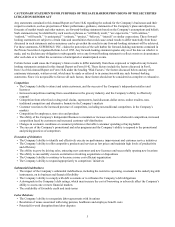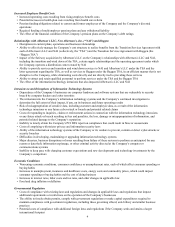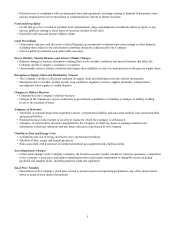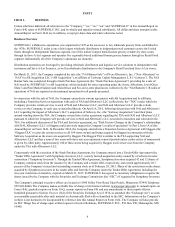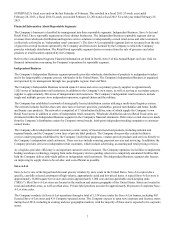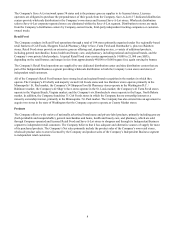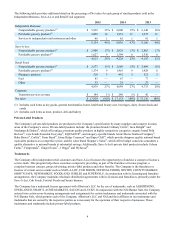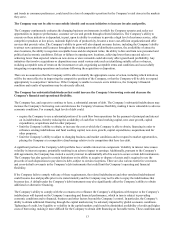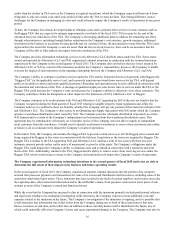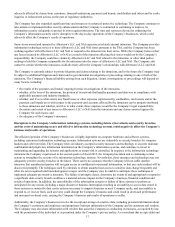Albertsons 2015 Annual Report Download - page 15
Download and view the complete annual report
Please find page 15 of the 2015 Albertsons annual report below. You can navigate through the pages in the report by either clicking on the pages listed below, or by using the keyword search tool below to find specific information within the annual report.13
and trends in consumer preferences, could result in a loss of competitive position for the Company’s retail stores in the markets
they serve.
The Company may not be able to successfully identify and execute initiatives to increase its sales and profits.
The Company continuously evaluates the changing business environments in which the Company operates and seeks out
opportunities to improve performance, customer service and growth through selected initiatives. The Company’s ability to
execute on these initiatives is dependent, in part, upon its ability to continue to provide a high level of customer service, offer
competitive products at low prices, maintain high levels of productivity, become a more cost-efficient organization and offer
services that provide value. The Company’s ability to grow will also depend on many factors, including the Company’s ability
to attract new customers and licensees throughout the existing networks of distribution centers, the availability of attractive
store locations, the ability to negotiate acceptable lease and development terms, the ability to hire and train new personnel and
political and economic conditions. Delays or failures in opening new locations, achieving lower than expected sales or
achieving lower than expected returns on new stores or store remodels could adversely affect growth and profitability. Any
initiatives that involve acquisitions or dispositions may entail various risks such as identifying suitable sellers or buyers,
realizing acceptable rates of return on the investment or sale, negotiating acceptable terms and conditions and successfully
integrating or separating operations and systems following the acquisition or disposition.
There are no assurances that the Company will be able to identify the appropriate course of action, including which initiatives
will be the most effective in improving the competitive position of the Company, or that the Company will be able to respond
appropriately to competitors’ initiatives. If the Company is unable to execute on its initiatives, the Company’s financial
condition and results of operations may be adversely affected.
The Company has substantial indebtedness that could increase the Company’s borrowing costs and decrease the
Company’s financial and operational flexibility.
The Company has, and expects to continue to have, a substantial amount of debt. The Company’s substantial indebtedness may
increase the Company’s borrowing costs and decrease the Company’s business flexibility, making it more vulnerable to adverse
economic conditions. For example, high levels of debt could:
• require the Company to use a substantial portion of its cash flow from operations for the payment of principal and interest
on its indebtedness, thereby reducing the availability of cash flow to fund working capital, new store growth, capital
expenditures, acquisitions and for other purposes;
• limit the Company’s ability to obtain, or increase the cost at which the Company is able to obtain, financing in order to
refinance existing indebtedness and fund working capital, new store growth, capital expenditures, acquisitions and for
other purposes;
• limit the Company’s ability to adjust to changing business and market conditions and to respond to market opportunities,
placing the Company at a competitive disadvantage relative to its competitors that have less debt.
A significant portion of the Company’s debt portfolio has a variable interest rate component. Volatility in interest rates causes
volatility in interest expense, potentially resulting in an adverse impact to earnings. Additionally, pursuant to the Company’s
debt agreements, the Company has created a security interest in substantially all of its assets to secure certain debt instruments.
The Company has also agreed to certain limitations on its ability to acquire or dispose of assets and is required to use the
proceeds of such dispositions to pay down its debt, subject to certain exceptions. There are also various restrictive covenants
and cross-default covenants in the Company’s debt instruments that could limit the Company’s operating and financial
flexibility.
If the Company fails to comply with any of these requirements, the related indebtedness (and other unrelated indebtedness)
could become due and payable prior to its stated maturity and the Company may not be able to repay the indebtedness that
becomes due. A default under the Company’s debt instruments may also significantly affect the Company’s ability to obtain
additional or alternative financing.
The Company’s ability to comply with the covenants or to refinance the Company’s obligations with respect to the Company’s
indebtedness will depend on the Company’s operating and financial performance, which in turn is subject to prevailing
economic conditions and to financial, business and other factors beyond the Company’s control. In particular, the Company’s
ability to obtain additional financing through the capital markets may be adversely impacted by global economic conditions.
Tightening of credit, low liquidity or volatility in the capital markets could result in diminished availability of credit and higher
costs of borrowing, making it more difficult for the Company to obtain debt financing on favorable terms. These conditions and


